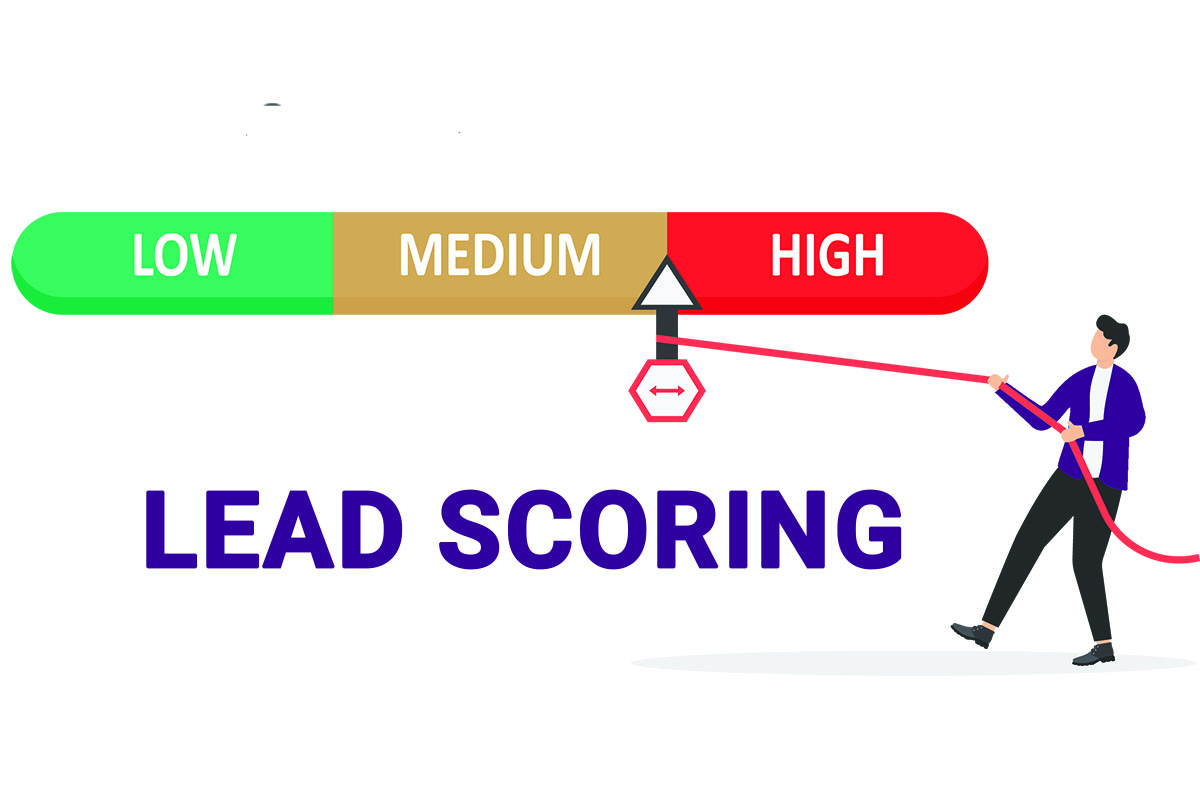Why Your Lead Scoring Isn’t Working — and How to Fix It for Real Results
October 29, 2025
Lead scoring is never really finished — it should evolve with your sales process.
Lead scoring is one of the most misunderstood (and most powerful) systems inside HubSpot.
Everyone wants it because it sounds like a fast track to “better leads.” But what most teams don’t realize is that lead scoring isn’t a one-time setup, it’s a living system that touches every part of your CRM.
When done well, it becomes the difference between chasing noise and focusing on the people who are truly ready to buy. When done poorly, it either floods your team with false positives or filters out almost everyone.
Let’s break down how to build it right — and keep it that way — using real examples of what can go wrong (and right).
Step 1: Start With “What Makes a Good Lead?”
Before you build a scoring model, you need to know who you’re trying to find. If you don’t already have a clear definition of a good lead, start with what you do know: the customers who actually bought.
Pull 6–12 months of closed-won deals.
Look for patterns in both contact and company data:
-
What industries buy most often?
-
Who are the decision-makers?
-
What paths did they take before converting (demo, trial, meeting, etc.)?
-
What behaviors signaled real intent — and which didn’t?
Those clues become your Fit (who they are) and Engagement (what they do) foundations.
One company I worked with had both a free community product and a paid enterprise version. At first, every free trial signup was being scored as a “qualified lead.” That buried the sales team in hundreds of low-intent contacts who just wanted the free tool.
Once we split the scoring into Fit + Engagement, we could filter for leads showing behaviors associated with enterprise interest — not just activity.
The result: far fewer “leads,” but a much higher conversion rate for the account executives.
Step 2: Build Using Real Data, Not Guesswork
Most scoring setups start with arbitrary numbers: “+10 for form fills, +5 for email opens, –5 for unsubscribes.”
But that’s not lead scoring — that’s guessing. Your best reference point is your existing customers.
Take a handful of your strongest clients and run them through your draft scoring model. Do they land in your SQL range? If not, your weights and thresholds are off.
Conversely, run a few weak or non-converting leads — they should fall low on the scale. If everyone lands in the same mid-range, you’re not differentiating well enough.
Another team I worked with thought they had a “lead problem” because no new contacts were qualifying.
When we reviewed their scoring, it turned out the logic was too exclusive requiring so many perfect conditions that no one could realistically score high enough to qualify.
Once we simplified the criteria and tested against actual known leads, the model began surfacing strong, realistic prospects again.
Step 3: Separate Fit from Engagement
HubSpot’s dual scoring model exists for a reason. A perfect Fit who hasn’t yet interacted isn’t the same as a highly engaged student or researcher who will never buy.
Keep your two tracks independent:
-
Fit Score = profile and company alignment
-
Engagement Score = actions and behavior
Then use a combination threshold to trigger workflows or stage changes.
This ensures your sales team sees leads that are both a match and active, not one or the other.
Step 4: Avoid Forcing the Outcome
Lead scoring works when you let the data speak.
One organization struggled because they tried to make the score fit individual contacts instead of defining what a qualified lead should objectively look like.
They’d say, “This person is a great lead, so let’s tweak the score until they qualify,” or “This one shouldn’t count — let’s change the weights.” Each tweak fixed one contact but broke the overall model.
The right approach is the opposite:
“Our best leads tend to have… [these traits or behaviors].”
That gives you a consistent baseline to measure everyone against.
Scoring should reflect your best customers — not your favorite contacts. Sure someone will be a surprisingly great lead and fall outside the model on occasion, but this is the exception. Set up your lead scoring for the most likely best prospects.
Step 5: Watch for Score Distribution
Healthy scoring has a curve — most contacts land in the middle, with a smaller group at the top ready for sales. If no one reaches your threshold, it’s too tight.
If everyone’s at the top, it’s meaningless.
HubSpot’s scoring insights show distribution ranges; check them often.
If the model starts skewing too high or too low, it’s time to rebalance.
Step 6: Understand That Everything Reacts to Lead Scoring
Every score change can trigger automation. That includes lifecycle updates, sales assignments, and lead-status workflows.
This is where many teams underestimate how powerful (and potentially disruptive) scoring is. Changing one scoring rule can shift dozens or hundreds of contacts into new stages or sequences overnight.
Before adjusting, review what automations depend on your score properties — especially anything tied to “greater than or equal to” thresholds.
Make changes gradually and watch the impact.
Step 7: Keep the Feedback Loop Alive
Lead scoring is never finished. It’s part of your continuous Loop — analyze, refine, repeat.
As campaigns evolve, buyer behavior changes, and your ICP sharpens, your Fit and Engagement weights will need updates. Review quarterly (or at least twice a year).
Ask:
-
Are new leads converting as expected?
-
Are we still surfacing the right people?
-
Do behaviors like “chat started” or “meeting booked” now carry more value than form fills?
Over time, your model will get smarter — but only if you keep feeding it real outcomes and adjusting accordingly.
Step 8: Check Who’s Being Excluded
Finally, make it part of your regular CRM hygiene to review contacts who aren’t being scored or who consistently score below threshold.
Missing data (like industry or role) or outdated filters can hide legitimate prospects.
Occasionally look at who’s not making it into your lead list — sometimes that’s where the gold is buried.
Final Thought
Lead scoring is about clarity, consistency, and confidence in where to focus.
The goal isn’t to make the number look right — it’s to make sure the right people earn the number. When built from data, tested against reality, and refined over time, lead scoring becomes one of the most reliable indicators of real opportunity.
Just don’t set it and forget it because the best systems evolve with you.
How do I know when my scoring model is “good enough” to activate workflows?
Don’t wait for perfection—wait for pattern confidence.
Once you can clearly see that your top-scoring contacts mirror your best customers and your low scorers rarely convert, it’s ready for pilot use. Start by activating the model for a limited workflow (for example, assign leads over 60 points to one rep or sequence) and monitor for two to four weeks. If conversions and response rates hold steady or improve, expand it. Lead scoring should start directionally right, not flawless—the feedback loop will handle refinement.
What if I don’t have enough data to build a Fit + Engagement model?
Use proxy indicators and build from assumptions you can later validate.
If you’re early-stage or haven’t tracked behavior yet:
-
For Fit, lean on firmographics (industry, company size, role seniority).
-
For Engagement, score the actions you can measure—email opens, demo requests, meeting booked.
Label your model “V1.0” and revisit once you have at least 25–50 closed-won deals or a few hundred leads with measurable activity. The key is to start simple and treat every quarter as a recalibration cycle.
Or export companies with deals won and ask AI to help identify the common characteristics . . .
How do I explain lead scoring changes to my sales team without causing chaos?
Communicate in outcomes, not algorithms.
When you adjust weights or thresholds, don’t just say, “We changed the scoring model.” Tell them:
“You’ll see fewer—but higher-quality—SQLs because the new model prioritizes engagement from decision-makers instead of all trial users.”
Or
“Expect more SQLs this month; we loosened the filters that were blocking valid leads.”
Providing why behind the change keeps everyone aligned and prevents distrust in the system. Follow up with a quick visual—like a histogram of score distribution—so they can see improvement rather than guess.


